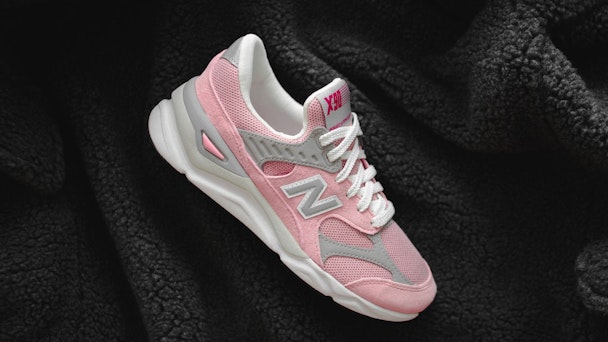‘It should have worked, but it flatlined’: the product launch that haunts New Balance
The sneaker market is saturated, and when a new shoe flops, it flops hard, as New Balance found out the hard way. Here’s how one disaster forced an entire company to rethink its research and marketing processes.

X-90 sneaker / Maksim Larin / Unsplash
The New Balance X90 shoe is a product that defines the career of the brand’s North American director of consumer insights and analytics, Charles Wilson. But not for the reason you might think.
Back in 2018, New Balance was not in the position it is now. The brand was failing to cut through in the competitive market. “We were finding it more challenging to connect with consumers,” Wilson recalls. “So, we conducted some qualitative work for an upcoming model.”
Advertisement
That model was the X90 shoe. Bosses wanted to gauge people’s opinion of it through a series of focus groups across various locations like Miami and LA, and the reactions were overwhelmingly positive, with many lauding the color scheme and comfortability of the sneaker. At the time, New Balance had more of a ‘dad shoe’ reputation, and the feedback gave the team confidence that they were on the right track to engage a younger, cooler audience.
The brand confidently took the shoe to market and celebrated with a massive launch party in August of that year. Influencers flocked to the retro-themed bash. Sales in those first three weeks were strong. Wilson said Google Trends reports into what people were searching for at that time correlated accurately with a spike in sales for New Balance. So far, so predictable.
But it was short-lived. “We had an immediate spike, then it dropped off and then flatlined,” he tells The Drum. “It should have worked; we trusted our research process.”
Advertisement
So, what went wrong? For answers, Wilson turned to Daniel Kahneman’s theory in the book ‘Thinking, Fast and Slow’ that what you see is all there is. And that was true for New Balance. It had created an artificial environment to test a product, and the results didn’t match the initial findings. The ‘real world’ is more nuanced, with things like age, income and different cultural touchpoints that can affect the very simple question: do I like this sneaker?
“We had some harsh conversations,” says Wilson. “But it was also a good moment for us to sort of reset and rethink our process.”
The researcher claims that the biggest epiphany from this failed product launch was that it’s not quite the linear path that they initially anticipated. The awareness, interest and desire that shone in the focus group didn’t hold in such a dynamic world. Consumers will pop in and out of a category and specific brands.
New Balance needed to bridge the gap between prompted exposure to a product and long-term real-world excitement. “There wasn’t this one golden piece of analysis that was unlocked, and then everything was solved,” he continues. “But when I look back at our research, we very much planned for the impact of the launch, but we needed to take a longer-term perspective.”
The brand then introduced the concept of ‘durable insights,’ making sure whenever it spoke with a consumer, the learnings would last multiple seasons. “If we got some immediate product reactions for the current season, we might understand what cultural touch points will be important for that second season,” explains Wilson. “But then understanding those deeper consumer needs for the third season, that helps us back upstream.”
During the launch of the X90 sneaker, Wilson admits they went ‘so heavy’ for the launch that they didn’t think about the product a year on. “If we’re going to launch a product, we need to plan for success,” he adds. “And assume that it will be in the market for at least three years, ideally four to five.”
Suggested newsletters for you
New Balance had to redefine its team structure to adopt this new mindset. Across the different departments - including design, merchandising and research - people were brought in earlier, and they stayed with the product longer. This shift had its challenges, though. “We were asking people to do things differently,” adds Wilson. “That’s not going to happen within a single season. We’ve made the hard yards and have new ways of working.”
And over time, it paid off. Helped by the rising popularity of ‘Dad shoes’ within the fashion world, New Balance was beginning to boost its cool credentials. Its research and updated ways of working, paired with influencer collaborations and celebrity endorsements, have seen the brand back in the spotlight in recent years.
Tapping into the crossover between sport and fashion is key. “If I think back to the launch of the X90, we didn’t have Coco Gauff winning the US Open, Kawhi Leonard and Jamal Murray winning NBA championships, or Saka and Sterling scoring goals in the World Cup,” Wilson explains. “We have the mentality of partnerships, not sponsorships. We’re not looking to sign as many brand ambassadors as possible, we’re looking for the right ones.”
The brand has come a long way since the X90 launch. Wilson cites Chelsea footballer Raheem Sterling playing in a Stone Island edition of its Furon boot during the World Cup last year as a standout moment. Even in the US, the subsequent capsule collection was received well.
“We were doing something unexpected, touching consumers across multiple interests. If you’re just into fashion or just into football, you would have seen that. But if you are that person at the intersection, that’s an incredibly relevant story to tell.”
Wilson reiterates that he does view his time at New Balance as two different eras. Post the haunting X90 launch, the brand still uses focus groups but it has a better handle on how it uses those insights and where it lies in the fashion and cultural landscape.
This article is based on a keynote presentation and The Drum’s interview with Charles Wilson, New Balance’s North American director of consumer insights and analytics, at the Esomar Conference in Amsterdam in September 2023.

